




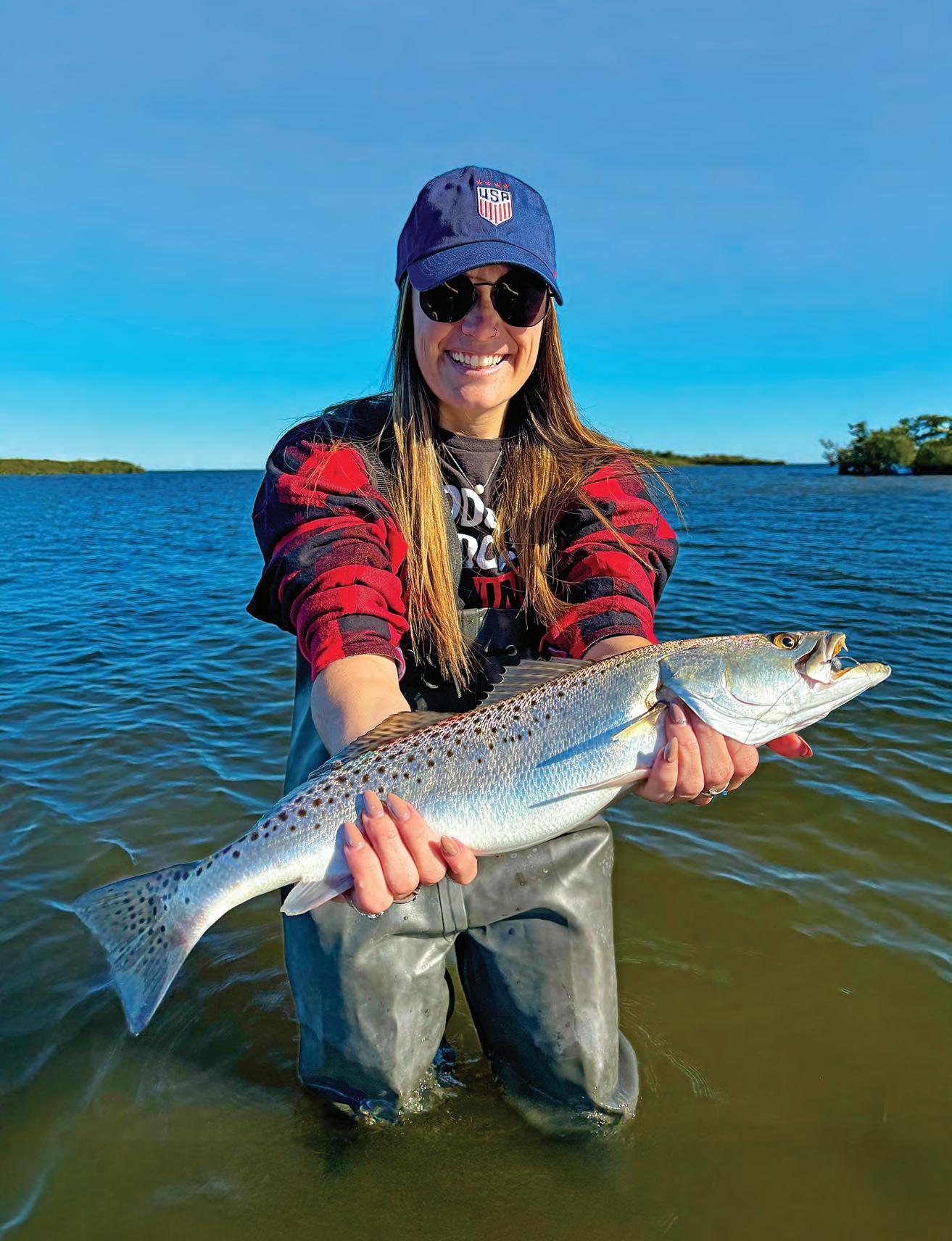





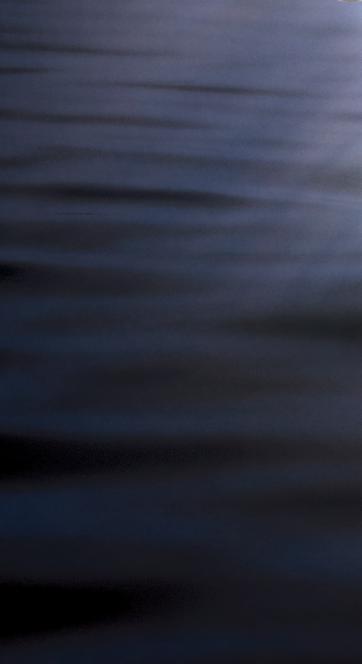




DRS4DNXTDRS6ANXT


You’re looking at it! Furuno’s award-winning Radar gives you clarity & target separation like no one else. Don’t take our word for it. See for yourself. Scan here, and we’ll show you!




























Embarking on the open water is an exhilarating experience, flled with the promise of adventure and relaxation. Whether you’re a seasoned sailor or a weekend cruiser, protecting your vessel with proper insurance is not just a choice—it’s a necessity. Explore the reasons why every boat owner should prioritize boat insurance for a worry-free voyage.
The open water can be unpredictable, with unexpected storms, collisions, or other potential accidents. Boat insurance can give you fnancial protection if there is damage to your vessel, providing coverage for repairs or replacement.
Accidents on the water can result in damage to other boats, docks, or even injuries to passengers. Boat insurance offers liability coverage, which can pay for damages or injuries you’re liable for while boating, up to specifed limits, and lawsuit costs if you’re sued. This includes damage you cause to another watercraft or if someone on or near your boat is injured and you’re found to be legally responsible.
Unfortunately, boat theft and vandalism are realities that boat owners face. Boat insurance has comprehensive and collision coverage that can protect you against events outside of your control, including theft and vandalism.
Accidents on the water may lead to injuries for you or your passengers. Boat insurance offers a range of optional medical payments coverage limits, helping to cover medical expenses if you are in an accident or someone is hurt on your boat, regardless of fault.
If you fnanced the purchase of your boat, most lenders require insurance coverage to protect their investment. Having boat insurance not only fulflls these requirements but also gives you peace of mind knowing that your fnancial interests are safeguarded.


Some water municipalities and marinas may require proof of insurance for docking or accessing certain areas. Boat insurance allows you the fexibility to explore different destinations without worrying about entry restrictions.
Emergency towing and assistance
Progressive boat insurance can include optional Sign & Glide® On-Water Towing coverage. If your boat is disabled or breaks down on the water, Sign & Glide® pays for on-water towing, jump starts, soft un-groundings, and fuel delivery.
Wreckage removal
If your boat sinks, Progressive boat insurance will cover the cost of removing your boat from the water (if removal is legally required).
Investing in boat insurance is not just about protecting a valuable asset; it’s about safeguarding the memories, experiences, and joy that come with your on-water adventures. Don’t let unforeseen circumstances disrupt your journey—navigate with confdence, knowing that Progressive boat insurance has you covered. Ensure a smooth and worry-free voyage, because when it comes to your boat, peace of mind is the ultimate luxury.
Scan to get a quote in as little as 4 minutes
learn more.

























If you love the outdoors and dream of being in business for yourself, now is the perfect time to make a change and choose a Coastal Angler or e Angler Magazine Franchise.
Ask one of our specialists about franchise territory availability in your area.









By Ben Martin, Editor in Chief
On December 11th at 3:00 p.m. the marine industry lost one of its kindest and most heartfelt supporters. A lifelong supporter of environmental awareness, the love of nature and teaching kids how to !sh, Rodney Smith was the earliest proponent of Florida’s groundbreaking net ban. He was the founder and publisher of the original Coastal Angler Magazine, creator and tireless volunteer of its Hook Kids On Fishing Program. Capt. Rodney Smith spent the better part of his life trying to improve the marine environment and sharing the wonders of the art and sport of !shing.
Rodney’s love and kindness was boundless.

Lifeguard, !shing captain, surfer, author, entrepreneur, and friend to all, Rodney Smith’s time on this earth was well spent helping others and showing love to Mother Nature and the marine environment.
Anyone whoever walked with Rodney would have invariably returned with a bag or pocketful of trash that he picked up along the way and then a erwards meticulously separated for recycling. Anyone whoever disparaged anyone else in Rodney’s presence would have immediately heard something positive about that person from Rodney. at’s just who he was.
Loving father, caring husband and faith driven entrepreneur, Rodney’s life was truly exemplary and saintlike. He will be missed, but he will also surely receive the same pat on the back and heartfelt “Good Job” that he gave to so many others while here.



Powered by twins, it runs over 30 knots and cruises efficiently at 20-30 knots. It’s a versatile, no-frills boat focused on rock-solid performance. Ideal for those needing a reliable, easy-to-maintain platform.
Powered by twins, the 20CC runs over 30 knots and cruises efficiently at 20-30 knots.
It’s a versatile, no-frills boat focused on rock-solid performance. Ideal for those needing a reliable, easy-to-maintain platform.




Whether you’re fishing in a kayak, canoe, or small boat, the ePropulsion eLite 500W redefines your on-water experience with innovative features and commitment to sustainability. Designed to be the most
and lightweight electric outboard in its class, it is an easy-to-use alternative to small internal combustion engines for enthusiasts worldwide. Max 5.6 miles at half throttle and 3.5 miles at full throttle. Experience the eLite Difference. Go Electric. Go Silent. Go Fishing!





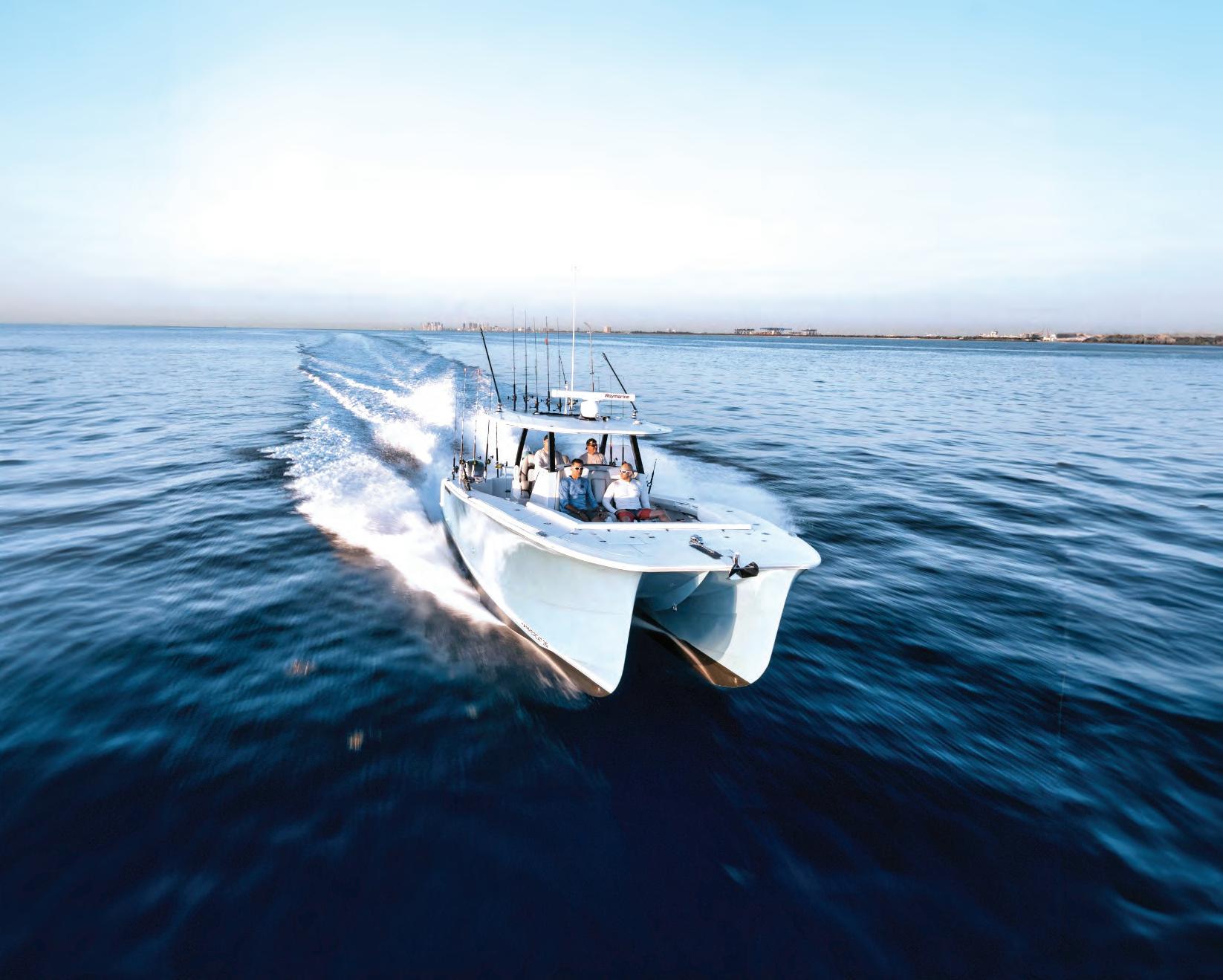






The Discover Boating Miami International Boat Show (DBMIBS) is set to return from February 12–16, 2025, bringing an extraordinary showcase of the marine industry. is annual event continues to draw boating enthusiasts, industry leaders, and newcomers alike, o ering a combination of innovation, and community.
Highlights of the 2025 Edition
Spread across six iconic Miami locations—Miami Beach Convention Center, Pride Park, Herald Plaza, Venetian Marina, Museum Park Marina, and Superyacht Miami at Yacht Haven Grande—DBMIBS provides a multifaceted experience.

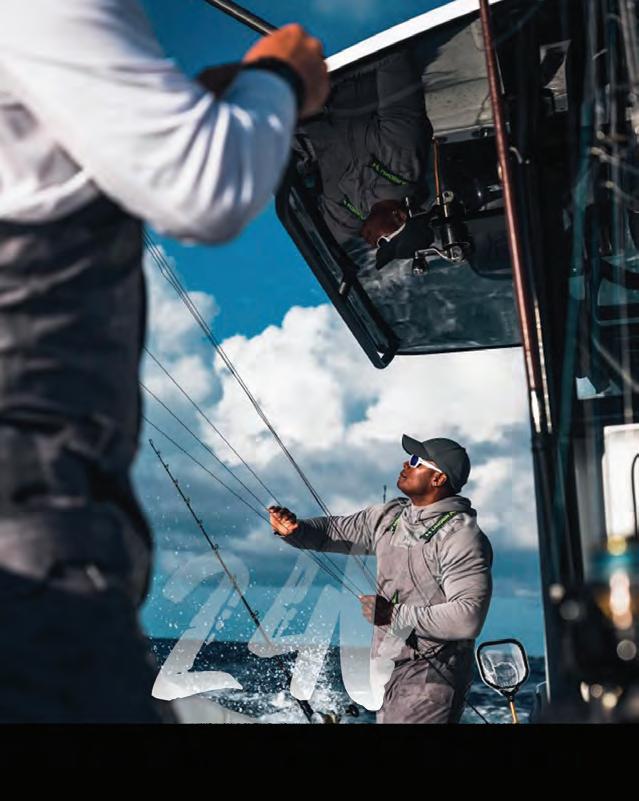
e Miami Beach Convention Center and Pride Park will host the latest in marine technology, boating gear, and vessels up to 49’’. On the water, Herald Plaza and Venetian Marina will feature a lineup of vessels, from sleek center consoles to high-performance powerboats.
A Boating Community Experience
e Progressive Boat Show Experience promises an engaging lineup of seminars, boating classes, and the popular AquaZone, an interactive space where attendees can test products and gain hands-on skills. For those looking to elevate their visit, Windward VIP tickets grant access to exclusive lounges, curated dining options, and concierge service.
Digital ticketing ensures a seamless entry process, with water taxis making it easy to explore the show’s sprawling venues. Water taxi tickets are sold separately.
From anglers to luxury yacht a!cionados, the show caters to all corners of the marine world. With its rich blend of exhibits, educational opportunities, and waterfront allure, it remains a must-visit event on the global boating calendar.
For more details and ticket options, visit www.miamiboatshow.com.







By Joe Woody
When winter descends upon the Smoky Mountains, the streams and rivers transform into a serene and picturesque setting. For avid anglers, this season o ers a unique and rewarding opportunity to !sh for trout. Cold water !shing in the Smokies during winter demands preparation, knowledge, and patience, but the solitude and satisfaction of hooking a trout in these crisp conditions make it all worthwhile.
Trout are cold-water !sh, and they remain active during the winter, albeit at a slower pace. eir metabolism decreases as water temperatures drop, making them less aggressive and more selective in their feeding habits. During this season, trout tend to conserve energy by holding in deeper pools or near submerged structures where currents are slow and food is more accessible.
e Smoky Mountains, known for their pristine streams and diverse aquatic habitats, provide excellent winter !shing opportunities. e recent storm damage has not changed that, although access and former topographical structuring may be somewhat altered the !sh have adapted and so will anglers. Rainbow, brown, and brook trout can all be found in the cold, clear waters of this region, with brook trout being particularly prevalent in the higher elevations.
Winter !shing requires careful planning to ensure success and safety. e Smoky Mountains can get bitterly cold in winter. Dressing in layers, including moisturewicking base layers, insulating mid-layers, and waterproof outerwear, is crucial. Gloves and a hat are always a must: Nymphs, midges, and small streamers are excellent choices for winter trout !shing. Patterns like the Zebra Midge, Pheasant Tail, and Woolly Bugger o en prove e ective. Since aquatic insect activity is minimal in winter, imitating small and slowmoving prey is key.
clear, low water conditions. Using light tippets (5x or 6x) and uorocarbon leaders can improve your presentation and increase your chances of a hookup.
Focus on deeper pools and areas with slow-moving water. Dead dri ing nymphs under an indicator or slowly

Winter trout can be extra wary due to the
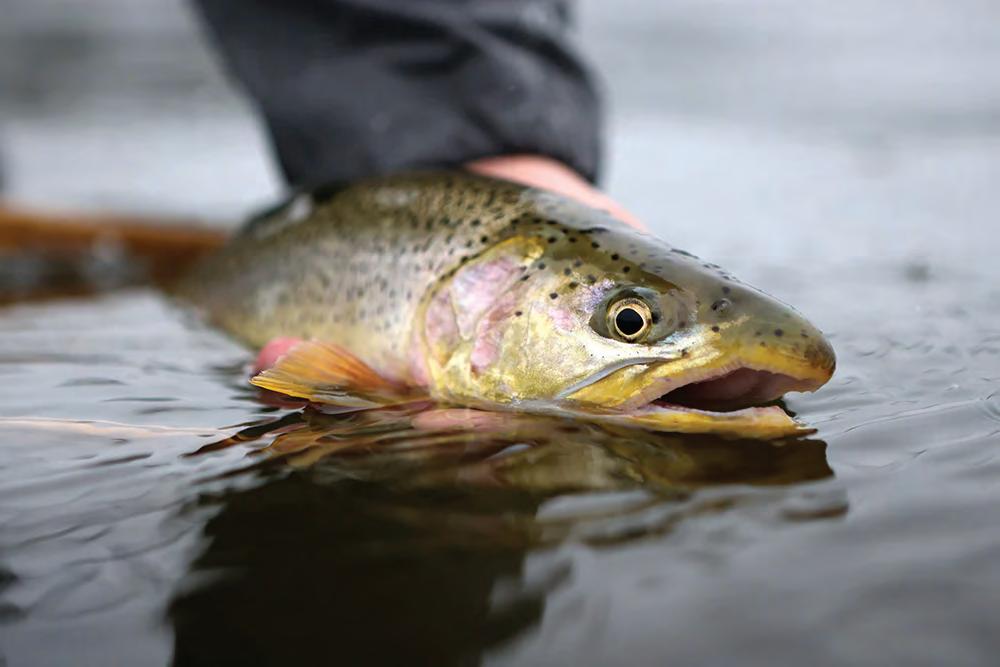
Townsend, this stream is a favorite among anglers for its healthy populations of rainbow and brown trout.
• Deep Creek: Known for its easy access just outside Bryson City, this area o ers a true remote !shing experience with just a short walk up its trail.
• Abrams Creek: Featuring clear waters and ample trout habitat, Abrams Creek is a reliable option for winter anglers
Winter trout are o en more active during the warmer parts of the day. Plan your trip to coincide with midday or early a ernoon. Low, clear water makes trout more alert to movement and noise. Approach the stream cautiously and keep a low pro!le. As any angler in these parts will tell you, always be mindful of slippery rocks and cold water. Wearing wading boots with good traction and a wading belt is essential.

retrieving a streamer can entice a bite. Pay attention to subtle strikes, as trout in winter o en feed so ly.
e Smoky Mountains are home to numerous streams, many of which are accessible year-round. Some top spots for winter !shing include:
• Little River: With easy access near
Fishing for trout in the Smoky Mountains during winter is a serene and ful!lling experience. e combination of tranquil surroundings, reduced crowds, and the challenge of cold-water angling creates an unforgettable adventure. With the right preparation and approach, you can enjoy the magic of winter !shing and make memories that will last a lifetime.


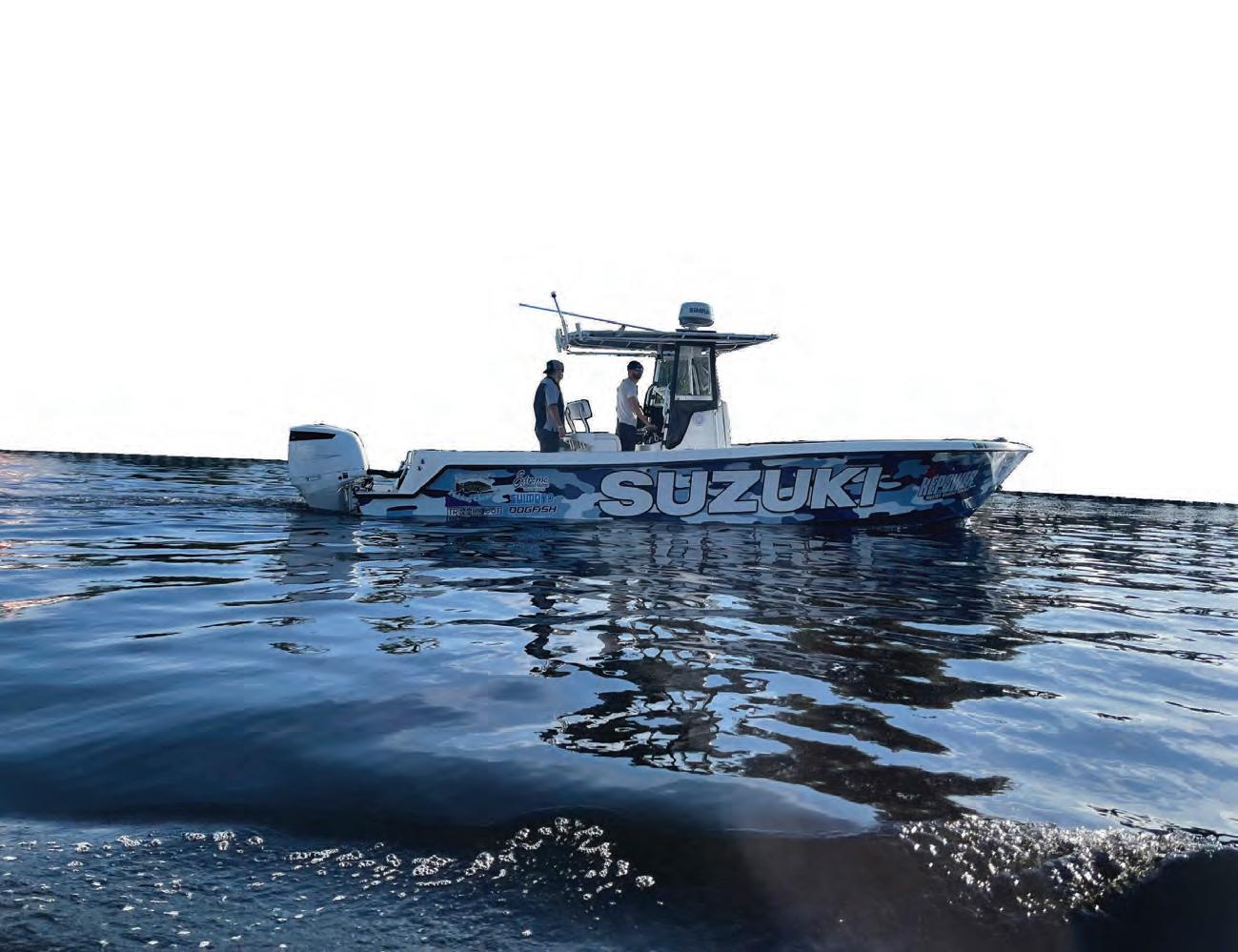
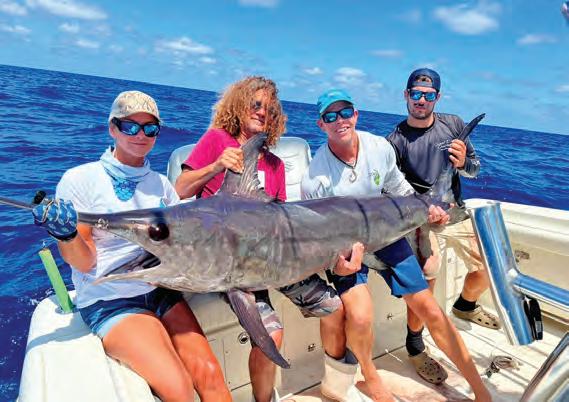
By Capt Quinlyn Haddon
Ihave been prompted to cover the topic of booking a charter a!er a recent experience I had that could have easily been avoided.
I was asked to work a charter with a company that I had never shed with before. e charter was booked last minute through a booking agency, that I will not directly mention. e notes of the booking repeatedly and clearly requested a full day o shore trip for yellow n. I went to meet with the captain, and helped him rig up for a tuna trip for the following day.
Yellow n tuna are not prevalent in the Florida Keys, but black n tuna are, so we informed the clients of this as we headed o shore in the morning.
Nearing the end of the trip, with a box full of tuna, the clients asked when we were going to get into the yellow n snapper.
e clients had wanted to sh inshore for yellowtail snapper, but they accidentally paid more for an o shore trip, simply because they used a booking agency and didn’t understand that yellow n and yellowtail were di erent species.
If you are wanting to book a charter, please call captains directly! Charter captains do not want to take you out on the water for a boat ride, we want to customize your day so you get the most out of it. Hearing about your expectations and helping answer your questions is paramount in our planning of your trip.
We do not do this job for the money, and most of us are scraping by. We have respect for what a big expense it is to book a charter. We understand that some groups may have saved up a long time to have this experience only once in their lives, and it is extremely important that we give you the trip you are looking for. We might even tell you to rethink the timing of your trip so you can come when your bucketlist sh is most targetable, something a booking agency knows nothing about. ey might be designed to take your money, but that is not what we are about.
If you nd a charter company you like through a shing booking agency, I would recommend going around them and calling a charter captain directly. Chances are that they have raised their prices to stomach the 30% fee the agency takes from them, and you can save money. Alternatively, they have not done so, and a direct call will put the money into the pocket where it belongs.
Booking agencies help ll the calendars, and for a lot of shermen whose strong suits are on the water, booking charters and advertising can be challenging. Some of the best captains have zero online presence. ere are a few agencies who aren’t as greedy as the one from this particular experience, and who may actually have knowledgeable people assisting you with your booking. However, nothing is going to beat speaking with the captain who you are hiring and sharing your day with.
We aren’t scary pirates or too busy to put in that phone time with you, and we are happy to connect with you before you book your trip. Give us a call!
Capt. Quinlyn Haddon guides with Sweet E’Nuf Charters out of Marathon, Florida Keys - (504) 920-6342. www.captainquinlyn.com; IG: @captainquinlyn






By Capt. Michael Okruhlik
he question of lure size is a common debate among anglers, and while di erent situations require di erent approaches, one thing is clear: sh don’t read shing articles or watch YouTube videos. ey eat when they want, and as anglers, it’s up to us to adapt. In my experience, adjusting lure size is more important than focusing on color—especially in winter shing for coastal species like trout, red sh, and %ounder.
When things aren’t going as planned, many anglers immediately reach for a di erent color. However, I nd size to be the more important factor. Fish are typically feeding on prey of a speci c size, not necessarily a speci c color. In my experience, changing the size of the lure is usually more e ective than changing its color. If size doesn’t produce a bite, I might try changing the style of the lure next.
As winter approaches, our estuaries undergo several changes: cooler water temperatures, shi!ing forage patterns, less boat tra c, and o!en clearer water. ese changes create two schools of thought about lure size: go bigger or go smaller. Some anglers upsize their lures for the entire season, while others prefer downsizing. Both strategies can work, and I will utilize both methods.
Cold fronts trigger cooling water temperatures and unpredictable sh behavior. Unlike the more consistent feeding patterns of stable weather, sh during early winter can make sh moody, switching between aggressive feeding and total inactivity. Late fall and early winter can be some of the best shing of the year, especially when schools of bait are %ushed out by falling tides. Hungry speckled trout and red sh follow these schools, and I prefer using smaller lures in these active feeding conditions. Fish are typically feeding on smaller prey like shrimp or shad, so a similarly sized lure is o!en the best match.
During these times, I also favor non-natural colors. When bait is abundant, sh can more easily spot a contrasting color, helping them target your lure amid the feeding frenzy. is is di erent from spring shing, where matching the color and size of the bait is key. In the fall and winter, standing out with an eye-catching color can be more e ective.
Another reason for downsizing in winter is clearer water. In some bays, water visibility improves signi cantly during the winter, reaching depths of 6-7 feet of clear water. Fish aren’t accustomed to this level of clarity and can be more cautious. In these conditions, a smaller, less intrusive lure will o!en get more bites. When I can clearly see my lure bouncing along the bottom, a small presentation tends to be more successful.
Winter shing requires %exibility. By focusing on size and action rather than color, and adjusting to factors like water clarity and post-frontal conditions, you’ll increase your chances of success. Fish may be moody, but with the right approach, you can adapt and still catch plenty of sh.
Capt. Michael Okruhlik is the inventor of Knockin Tail Lures® and the owner of www.MyCoastOutdoors.com.


Announces 2025 Dates
The 2024 Fort Lauderdale International Boat Show (FLIBS) celebrated 65 years, drawing over 100,000 attendees from around the globe to experience the largest in-water boat show in the world. Produced by Informa Markets and owned by the Marine Industries Association of South Florida (MIASF), the event has historically featured more than 1,300 boats and 1,000 brands, generating $1.79 billion in economic impact for the region.
“As FLIBS celebrates its 65th anniversary, we’re proud of the ongoing growth and excitement this show brings to our guests and the Fort Lauderdale community,” said Andrew Doole, President of U.S. Boat Shows with Informa Markets. “With each FLIBS, we remain committed to creating an elevated experience that brings the boating and yachting world to the heart of Fort Lauderdale.”
Each year, the FLIBS Best of Show award honors exceptional debuts that showcase outstanding performance, technology, and craftsmanship. This year, in response to an overwhelming number of nominations, organizers expanded the award for the first time in the show’s history to include two distinct categories—vessels over 60 feet and vessels under 60 feet. Mangusta, marking its third win, took top honors in the over-60-foot category with the U.S. debut of its Oceano 44. In the under-60-foot category, the Mag Bay 38 CC claimed the award, marking a first-time win for the brand.

across seven iconic venues. The Windward VIP Lounge, now located at the Hall of Fame, provided an exclusive setting with premium amenities and stunning views, making it the ideal backdrop for the show’s first-ever Celebrity Chef demonstration. VIPs were captivated by a unique culinary collaboration featuring Below Deck’s Chef Dave White and Hell’s Kitchen champion Ryan O’Sullivan, who impressed guests with their skills and dynamic showmanship.
Pier Sixty-Six Hotel & Marina “Pier South” was transformed into an impressive venue for
yacht ownership, sustainability in the sector, and chartering opportunities, fostering meaningful conversations among owners, industry leaders, and prospective buyers.
Meanwhile, the newly opened Las Olas Marina showcased an impressive selection of brokerage vessels, and the expanded footprint at Pier Sixty-Six hosted yachts up to 236 feet, underscoring FLIBS’ commitment to providing a diverse array of exhibits and products for consumers.
At the Broward County Convention Center, guests explored an array of fishing boats, personal watercraft, and marine accessories, while educational seminars covered topics like conservation, sustainable practices, and fishing techniques. Captain Don Dingman’s popular Kids Fishing Clinics created memorable moments for young attendees, and interactive exhibits at The Blue Wild Expo’s FLIBS Kids Corner further made the show a family-friendly experience. The Island Bar of the Convention Center presented by Suzuki provided fun refreshments for guests to enjoy as they walked the convention hall.

FLIBS offered elevated guest experiences
Superyacht Village, welcoming some of the world’s largest and most luxurious superyachts. Among the stunning vessels on display was Amaryllis—the show’s largest yacht at over 200 ft, built by Abeking & Rasmussen—giving guests an up-close look at superyacht craftsmanship and design at its finest. This setting also provided the ideal atmosphere for in-depth discussions and presentations on the latest yachting trends. This year’s programming highlighted important topics, including mental health in the industry,
In its commitment to sustainability, FLIBS partnered with Allini Water Filters to provide water refill stations, encouraging eco-friendly practices, and reducing singleuse plastics. Through a collaboration with the Water Revolution Foundation (WRF), FLIBS raised $7,500 in guest donations to support marine conservation efforts. This year, attendees were invited to contribute to WRF’s Important Marine Mammal Areas (IMMAs) program when purchasing tickets, directly supporting the identification and protection of critical habitats in popular boating regions like the US East
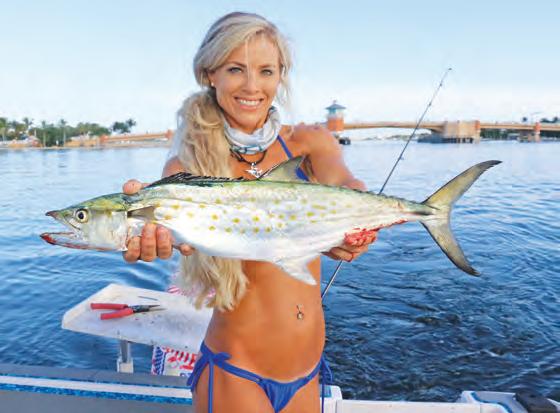
Please be sure to check out my YouTube Channel “Darcizzle Offshore” for fishing videos every week! www.youtube.com/DarcizzleOffshore
Happy New Year Anglers! Start off the New Year right and take advantage of the fantastic fishing we are blessed with off Palm Beach County! The sailfish sector aka ‘Sailfish Alley’ of the Gulfstream is at its prime this month. The sailfish bite best when a chilly north wind starts howling, kicking up the seas as it plows head-on into the Gulf Stream and stacking up the bait. A general rule of thumb to remember, the sailfish bite improves the first few days following a cold front. Anglers should look for pods of bait on their depth finder, a clean water edge or a temperature break that will lead you to the fish. A majority of anglers fishing offshore this month will be deploying kites for kite fishing, allowing anglers to have the best bait presentation possible.
TIP: You should consider purchasing a drift anchor if you have a center console. A drift anchor will help you stay in the depth you are fishing longer, especially when the winds are howling and pushing your vessel out of the strike zone. Historically, productive areas for sailfish range from the Jupiter ledge, to the waters in front of the Breakers and the Ritz Carlton, down to Boynton’s water tower, the ‘Martini Glass.’ Depth is key when kite fishing; you should target your efforts between 80-250 feet of water for sailfish until you determine the best depth for that day.
If the seas are fairly calm this month, try to explore further offshore to find the occasional dolphin or wahoo. While traveling to and from your fishing grounds you should be on the lookout for cobia swimming in the shallows close to the beach. Also, along the beaches pompano, bluefish and Spanish mackerel will be plentiful. Spanish mackerel put up a hard fight on light tackle and are great table fare, with fish 5-7lbs not uncommon. You can target Spanish mackerels from boat by trolling depths 10-25ft and casting colorful jigs, spoons or swimming plugs along the beach. For land based anglers, the Juno and Lake Worth pier, and rock piles off Boynton Inlet should produce a good bite.
For those anglers that love to bottom fish, set up your drifts in depths of 60 to 120 feet near wrecks and reefs. Drift your baits using a triple hook rig with a dead sardine or a chicken rig with a sinker, as both should yield muttons, yellowtail, mangrove snapper and kingfish. Until next time, keep on catchin’!

































Sea Tow is happy to extend it’s service to include tows from Nothern Bahamas, Green Turtle, West End Marsh Harbour, Hope Town and Grand Cay to the U.S.
Whether you need a timely tow or help offshore, Sea Tow Captains are standing by 24/7.
Why wait? Join today and get 2 months free! (That’s a $28 value!) Use discount code: TCT. Join Sea Tow Palm
By Keith Lozott
Typically, I don’t believe in superstitions, but a er a recent shing trip with my buddy Neil, I may be a believer!!! e morning started slow; I caught a small snapper and small snook. Neil was in skunk mode, so we decided to try a spoil island where I’ve caught some trout, snook, and a gag grouper on a prior trip. To our dismay it was dead as well. Just as we were about to exit stage le , Neil was working a topwater lure back to the boat when what appeared to be a large bull shark came up from the bottom and tried to hammer the lure. Unbelievably it totally missed the lure and disappeared. It was impressive to witness such a big specimen of a sh take a swipe at the lure.
A er the “Shark Week” experience, we continued to struggle so I decided to implement Plan C and move from the east side of the Indian River to the west side. I’ve had some nice shing on the west side with trout, reds, and snook. We made our way across the river stopping at another spoil island only to be greeted with a jack attack. I landed several jacks and Neil hooked one that got o . His skunk was still intact but with jacks around I gured that would change. Unfortunately, that wasn’t the case.
Typically, I don’t believe in superstitions, but a er a recent shing trip with my buddy Neil, I may be a believer!!! e morning started slow; I caught a small snapper and small snook. Neil was in skunk mode, so we decided to try a spoil island where I’ve caught some trout, snook, and a gag grouper on a prior trip. To our dismay it was dead as well. Just as we were about to exit stage le , Neil was working a topwater lure back to the boat when what appeared to be a large bull shark came up from the bottom and tried to hammer the lure. Unbelievably it totally missed the lure and disappeared. It was impressive to witness such
We used the trolling motor to quietly make our way towards the mangroves hoping to get a glimpse of a red, snook, trout, ounder, or any inshore species willing to bite. As we approached the shore, we noticed another bull shark working the shore and of course I had to make a cast or two at him, but he had no interest in my o ering. We kept working the shore and nally it happened for Neil!!! He made a long cast and almost as soon as the lure hit the water, he was on with a nice sh, but we couldn’t see what it was. He started gaining ground getting it closer; enjoying the ght and then it happened! e sh came unbuttoned and at this point I was like dude, what did you do in a previous life to deserve this??? We made our way toward a dock that I know holds snook. I made a long cast and right then I was hooked up with a huge sh. It was a big snook; I got her to the boat, revived her, and released her to ght another day. Success! I said, “let’s go to lunch and call it a day”. I asked Neil if he was hungry and then he disclosed to me that he ate a banana for breakfast! Neil knows not to bring bananas on the boat (it’s bad luck), but it didn’t occur to him that the curse would remain in e ect with it digesting in his stomach. Myth con rmed or was it bad luck? He should’ve brought his lucky rabbit foot!!! Keith Lozott The Fishing Realtor

A er the “Shark Week” experience, we continued to struggle so I decided to implement Plan C and move from the east side of the Indian River to the west side. I’ve had some nice shing on the west side with trout, reds, and snook. We made our way across the river stopping at another spoil island only to be greeted with a jack attack. I landed several jacks and Neil hooked one that got o . His skunk was still intact but with jacks around I gured
We used the trolling motor to quietly make our way towards the mangroves hoping to get a glimpse of a red, snook, trout, ounder, or any inshore species willing to bite. As we approached the shore, we noticed another bull shark working the shore and of course I had to make a cast or two at him, but he had no interest in my o ering. We kept working the shore and nally it happened for Neil!!! He made a long cast and almost as soon as the lure hit the water, he was on with a nice sh, but we couldn’t see what it was. He started gaining ground getting it closer; enjoying the ght and then it happened! e sh came unbuttoned and at this point I was like dude, what did you do in a previous life to deserve this??? We made our way toward a dock that I know holds snook. I made a long cast and right then I was hooked up with a huge sh. It was a big snook; I got her to the boat, revived her, and released her to ght another day.
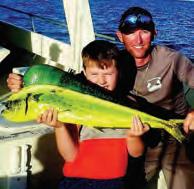

Success! I said, “let’s go to lunch and call it a day”. I asked Neil if he was hungry and then he disclosed to me that he ate a banana for breakfast! Neil knows not to bring bananas on the boat (it’s bad luck), but it didn’t occur to him that the curse would remain in e ect with it digesting in his stomach. Myth con rmed or was it bad luck? He should’ve brought his lucky rabbit foot!!!
Keith Lozott The Fishing Realtor
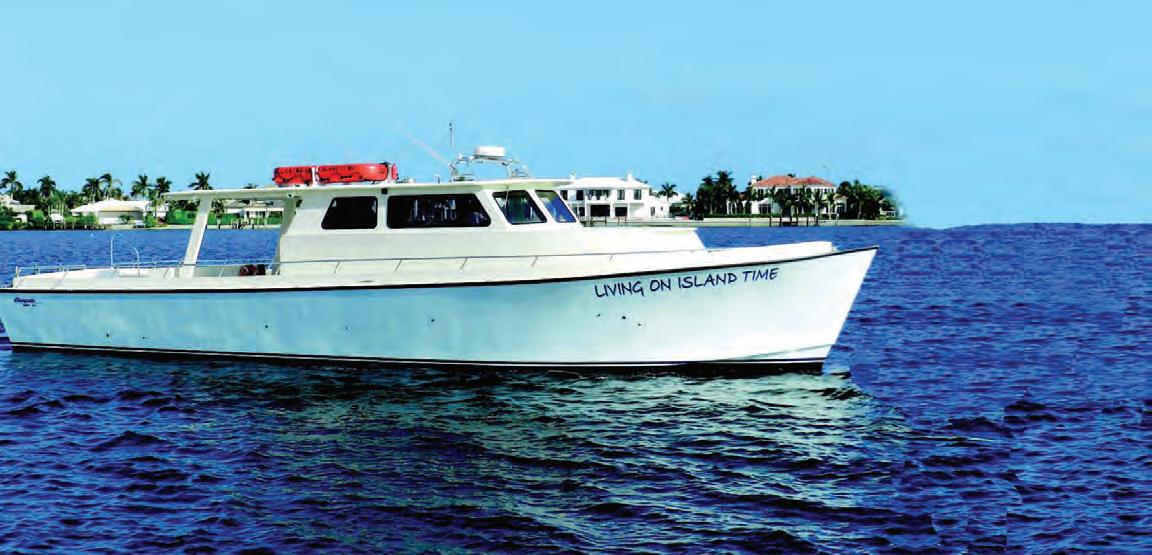
$130 per person tuesday special 1:00pm-7:00pm (6-hours)
$80.00 per person
Sailing two trips daily, 7 – days a week! 8am – Noon • 1pm - 5pm (Tuesdays 1-7pm) Night trips – Wednesday & Friday 6pm – 10pm seasonally – call for more info. Plenty of free PArking very close to the boAt! give us a try and see what everybody is raving about! We put the “FUN” back into drift boat fishing! so sit back, relax you’re on island time!
fish tripsBoth tuesdayoN



Hope everyone had a wonderful holiday season and you’re enjoying a fun start to your new year! In this column I try to suggest a variety of ideas for exploring and learning about Florida’s natural environments.


One way to really get up close and personal with Florida’s natural areas is through volunteering. For people who enjoy the feeling of contributing to their community and don’t mind getting their hands and clothes a little dirty, the start of a new year is a great time to get involved while also learning a lot about Florida’s unique ecosystems!
It’s easy to forget when we’re sitting in traffic, or dodging people in the aisles at Costco, but there’s still a huge amount of land - even here in South Florida, that has been preserved and set aside for the public to enjoy as natural areas.
Everglades, Big Cypress, and Biscayne National Parks are massive, federally managed lands. Others smaller but still good-sized natural areas, like Corbett WMA, MacArthur Beach State Park, and Grassy Waters Preserve are managed by the State of Florida or local cities, towns, or counties.
And there are plenty of smaller areas too - the kind you drive past by car or by boat but may never have visited or even heard of - like Green Cay Wetlands, Delaware Scrub, Cypress Creek Natural Area, and Tarpon Cove.
Almost every single natural area in Florida can benefit from motivated volunteers working as a group. And while the very smallest natural areas may just have a couple parking spaces and no staff on site, many natural areas are associated with nearby nature centers. This often boosts the frequency and attendance for volunteer events at these areas.
So what opportunities are out there? Just google “volunteer at ________ natural area” to see:
• be a hiking trail steward
• help remove invasive exotic plants from wooded areas
• be a tour guide or help raise funds for your favorite nature center
• plant mangroves or create new oyster reefs as part of a habitat restoration project
• survey for birds, fish, and other creatures as part of an annual migration study
• paddle waterways each week to collect water quality data
• help take care of orphaned and injured wild animals
• pick up trash and debris from beaches and shorelines
• join a sea turtle survey or rescue team
There’s an incredible variety of options out there and I hope you’ll consider volunteering a few hours of your time this year. Together we can help make a difference for our natural areas!
Hope to see you on the water! Aqua Adventure Tours, Inc. • 561-635-6899 • www.aquaadventuretours.com

Ira got a rare catch on hook and line, it’s a lionfish and a giant one.


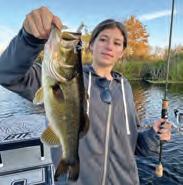
HJenna got into some great ultralight fishing in the Everglades.

Noah and his dad Noor caught two sailfish and a beautiful mahi in just a couple hours.
appy New Year! Here is your January inshore and freshwater fishing forecast. As the cold fronts keep rolling in so will the migrating fish. It seems like we will be seeing new species every few days. First place to check is going to be the beach, if the wind allows it, look for birds working which should lead you to the fish. Ladyfish and bluefish will come easily but if you keep searching you will most likely be rewarded with some nice pompano. Your best choice for pompano is a pink and white or yellow and white Goofy Jig with a quill. These fish all make great targets with a fly rod with a fly and a similar colored Clouser. I would suggest tying on a wire trace as the mackerel and bluefish are toothy and the ladyfish just have rough mouths. None of these species are very leader shy so a piece of number four wire will work just fine. This can also be a great time to keep a bigger spinning rod ready for the spinner sharks that will most likely be looking to eat whatever you hook. In the inlet, sheepshead will start to become the prime target as they spawn. In February it will be clear where they are located by the big swarm of boats. Shrimp and jigs will get you hooked up quick either with a sheep or the big schools of jacks that hang in the inlet. Sharks were a big issue last year so I would suggest going larger than normal on your tackle so that you can land your fish faster. The local freshwater fishing can be a little tough in January depending on how chilly the water gets. I usually suggest to my clients that we head down to the northern Everglades and fish the Alligator Alley area. This section tends to stay productive throughout the winter, spring, and into the early summer. It’s also a great place to check out the scenery and wildlife, both are amazing. Most days you will see a lifetime supply of alligators. While I suggest not eating fish from freshwater in South Florida, I definitely would say not to eat anything from the Everglades despite what you might hear on YouTube. The mercury levels are off the charts so practicing catch and release is the best bet for your health and for our future generations fishing. It’s a great place to go and you don’t need any live bait. You can topwater fish, throw jerk baits, or they absolutely go nuts for a fly. If you’re into ultralight fishing like I am, a 4-pound test rod with a marabou jig is an absolute blast and you will probably catch 100 fish per day.
Good luck out there and I hope you have a great start to the new year!


Local networking led to the discovery of a deep-water wreck that always produces.

By Walker Ford

WBy Mark Ambert
The excitement could be felt. Mahi were on the move again but where? I hadn’t been on the water in a while and didn’t want to lose valuable time scouting. A few quick checks with my networking sources yielded insights and answers. I ended the day happy and with what I was after – a beautiful pair of mahi!
Fishing is more than just a solitary pursuit. It’s a community full of shared knowledge, experiences, and camaraderie. For anglers looking to elevate their skills, networking and community engagement can be invaluable tools. Connecting with others can significantly enhance your fishing experience and help you understand current conditions as they unfold.
One of the most significant benefits of networking is the opportunity to learn from seasoned anglers. Whether through local fishing clubs, online forums or social media groups, engaging with experienced fishermen allows you to gain insights into techniques, gear selection, and effective strategies. These interactions often provide tips that can only be learned through years on the water.
Every fishing location has its own unique aspects, and local anglers are often the best resource for understanding these nuances. By networking within your community, you can discover prime fishing locations, seasonal patterns, and the best bait and tackle for your area. This localized knowledge can be the difference between a successful trip and a frustrating day on the water. Local bait and
CONTINUED ON PAGE 7 >>
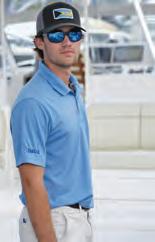
alker grew up in Fort Lauderdale, Florida and has been fishing and boating his entire life. He bought his very first boat at the age of 12 where he spent endless days, and summer nights, bass fishing in the Everglades with his dad. He now spends most of his time free diving and fishing off the beautiful coasts of Florida and the Bahamas. Walker’s first job was at West Marine as a salesman. He then moved on and worked at a marina as a dock master. He currently works at Tuppen’s Marine. His enthusiasm for being on the water has led him on his path toward boat sales. Walker’s hard work and dedication to the boating and marine industry has allowed him to develop a keen eye for detail and an ability to understand the needs of clients. Walker is committed to providing exceptional service and helping clients find their dream boat. With knowledge of the latest trends in the yacht industry and familiarity with various types of boats on the market, Walker is well equipped to help clients make informed decisions about their purchase. Whatever your boating needs are, Walker can help you find what you’re looking for!
































Knowledge sharing is a common activity on social media groups.

tackle shops within your target area are a great place to start.
Many fishing clubs host workshops, seminars, and skill-sharing sessions. Participating in these events is an excellent way to learn new techniques such as casting, knot tying, and bait presentation from the local experts. These hands-on experiences often foster a deeper understanding than by simply reading about a subject.
Fishing can be challenging, with many factors affecting your success. Building relationships with fellow anglers creates a support system where you can share experiences, discuss challenges, and celebrate your catches. This community support can boost your confidence and motivation, while honing your skills.
Finding local captains, fishermen, and fishing charters are a great way to learn a new area and jumpstart your fishing success. Most of these dedicated resources are on the water daily.
Joining a fishing club that sponsors group outings is an excellent way to network while improving your skills. These outings provide the opportunity to fish with others who may have different approaches and techniques. Find a mentor who is willing to share their knowledge and experiences. Offering to split fuel costs, paying for supplies like live or dead bait, and picking up food for the day will improve your chances for a second invite. Stay and help clean fish or the boat - Captains’ choice.
Participating in these shared experiences can help you pick up new skills while enjoying the camaraderie of fellow anglers.
The rise of social media has made it easier than ever to connect with other anglers. Online forums and social media groups focused on fishing allow you to ask questions, share personal experiences, and learn from a diverse group of people. Participating in these online communities can
broaden your understanding and expose you to different fishing styles.
Following captains and skilled fishermen on places like Instagram, YouTube, and Facebook can also give valuable insights into fishing opportunities and what’s being caught locally.
PRO TIP – I follow resources that fish areas north and south of my home port. This provides valuable information on fish movement along the coast.
Engaging with fishing communities online can also inspire you to create and share your own content through blogs, videos, or social media posts. Sharing your fishing journeys and learning experiences can foster connections and inspire others, creating a cycle of learning and sharing within the community.
Networking also provides a platform to promote conservation and sustainable fishing practices. Engaging with like-minded anglers can foster discussions on responsible fishing, habitat preservation, and ethical practices, contributing to the overall health of marine life.
In summary, networking and community engagement are essential to improving your fishing skills. By connecting with experienced anglers, sharing knowledge, and participating in group activities, you can enhance your techniques and build valuable, long-term relationships. Whether you’re a novice or a seasoned pro, embracing the community aspect of fishing can lead to greater success, enjoyment, and a deeper appreciation for the great outdoors.
It’s a new year and with new opportunities to grow and learn. So, get out there, make connections, and cast your line into the productive waters of community engagement.
Mark Ambert, IG @marksgonefishing_™ marksgonefishing25@gmail.com_
Staying aware of conservation efforts allows you to participate in our ecological future.

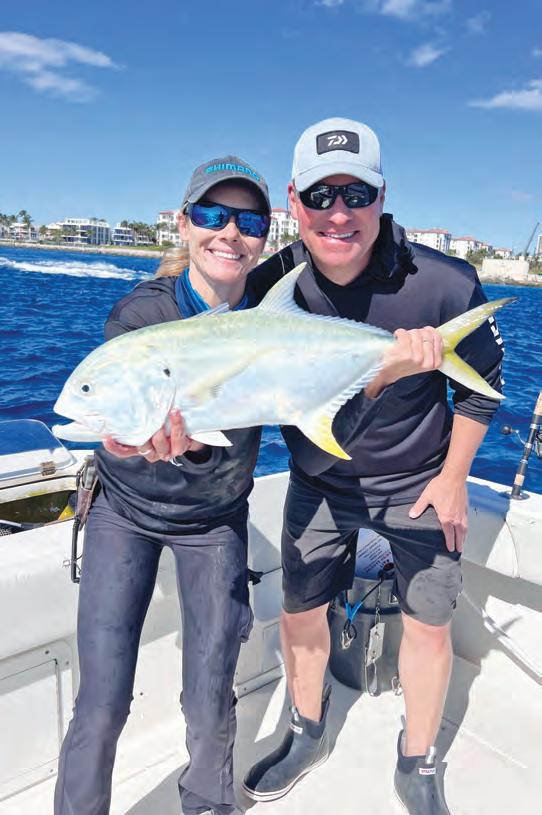
Expect hundreds of jack fish to invade the inlets this month.
Welcome to the January Coastal Angler Magazine fishing forecast for the waters off Palm Beach, Singer Island, and Juno Beach.
Finally, the cooler air has pushed the fish down the coast and the fishing has picked up. For the offshore anglers, you’re going to find sailfish and dolphin on the surface. Kite fishing is the method of choice for us over here at Reel Intense Fishing, but it’s the bottom that will be on fire! Huge muttons and fat yellowtails will be lurking deep looking for something to eat. Also, vermillion snapper will be in the mix. Small live scale bait works the best for muttons but cut bait will work best for tails & beelines. When there is a big swell, you will find them on the first reef. Kings will also be starting to show up. When bottom fishing, make sure to have a flat line out. Fish on! The inshore bite along the beach will also be productive. Cobia, jumbo jacks, and Spanish macks will be heading south and will be ready to bite the hook. Don’t be afraid to run the beach sight fishing. Only stop when you see something good to fish on. It’s been slow on the live bait front. If you need live bait, contact the bait boys on VHF 68. This saves time and aggravation, trust me. Good luck and tight lines!

Happy New Year! January offers a plethora of species to target throughout Jupiter and Palm Beach. Typically, cool fronts bring cool water temperatures and seasonal weather. The cooler northeast winds bring in migratory schooling fish for anglers to battle. The Intracoastal waters will be teaming with jacks, tarpon, snook, drum, sharks, and many other species. Live baits work great, as well as artificial baits like D.O.A. C.A.L 3” Shad Tail in glow/gold belly rush and D.O.A. Shrimp. Remember to work your baits slow and work the area you are fishing thoroughly. Look for any signs of bait and birds signifying fish are in the area.
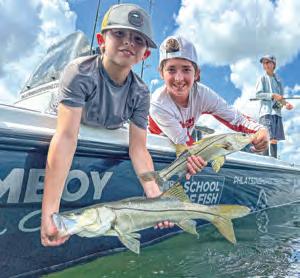
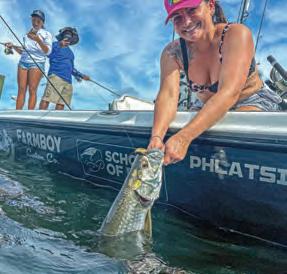
Snook can be found cruising shallow flats, docks, and seawalls. Artificial baits like a D.O.A. 3” Shrimp and D.O.A. C.A.L. Curl Tail are awesome baits to get linesiders to chew. The bigger snook can be found around bridges and deep holes ranging from 5 to 20 feet.
D.O.A. TerrorEyz and C.A.L. 3” Shad Tails are both excellent baits to jig the bottom for rod bending action.
Channels, mangrove shorelines, and seawalls will offer great fishing for jacks, bluefish, mackerel, drum, pompano, and snook. Clean and moving water are the key for successful fishing.
Well, that is the fishing report for Jupiter and Palm Beach, hope you all enjoyed.
Remember, you can’t catch them from the couch, so get out there and get hooked up. Tight lines!
Coast, Bahamas, Gulf of Mexico, and the Caribbean. Additionally, FLIBS teamed up with LIND, a surf-culture brand, to present “A New Way to Play”—an innovative exhibition blending art and technology, featuring 16 unique surfboards designed by 12 renowned contemporary artists. Following FLIBS, the exhibition continued to Miami Art Week in December, culminating in an auction to benefit Oceanic Global’s ocean conservation initiatives.
“For 65 years, FLIBS has been more than just a showcase of the marine industry—it’s become an integral part of our local economy and community,” said Phil Purcell, CEO and President of MIASF. “As we celebrate this year’s milestone, we’re proud of how the show continues to evolve, innovate, and serve as a cornerstone of our industry.”
Following this milestone celebration, FLIBS will return from October 29 to November 2, 2025, to bring another world-class experience to the city of Fort Lauderdale. For more information and updates, visit www.FLIBS.com and follow FLIBS on all its official social media accounts.


1
5
5:44
8 Wed 3:36 2.5 3:41 2.3 9:45 0.3 10:13 -0.3 7:08 5:45
9 Thu 4:43 2.5 4:46 2.3 10:49 0.2 11:14 -0.4 7:08 5:46
10 Fri 5:47 2.6 5:50 2.4 11:49 0.2 7:08 5:46
11 Sat 6:46 2.6 6:49 2.5 12:12 -0.5 12:46 0.1 7:09 5:47
12 Sun 7:39 2.7 7:43 2.5 1:07 -0.5 1:39 0.0 7:09 5:48
Mon 8:27 2.7 8:33 2.6 1:58 -0.6 2:29 0.0 7:08 5:49 14 Tue 9:12 2.7 9:19 2.6 2:47 -0.5 3:16 -0.1 7:08 5:49
Wed 9:54 2.7 10:04 2.5 3:33 -0.5 4:01 -0.1 7:08 5:50




















20 Mon 12:55 2.1 1:02 2.1 7:11 0.3 7:37 0.1 7:08 5:54
21 Tue 1:42 2.0 1:45 2.0 8:00 0.4 8:26 0.1 7:07 5:55
22 Wed 2:35 2.0 2:33 1.9 8:54 0.5 9:19 0.1 7:07 5:56
23 Thu 3:33 1.9 3:29 1.9 9:52 0.5 10:14 0.1 7:07 5:56
24
25 Sat 5:34 2.1















































One of America’s oldest fishing clubs has a new President. The board of directors of the West Palm Beach Fishing Club (WPBFC) has named Tom ‘Buzz’ Bzura, of North Palm Beach, as the organizations new President. Buzz has been working at the WPBFC for the past eight years, most recently serving as the organization’s Managing Director. In his new role as WPBFC President he will be responsible for producing all angling programs, the famous Silver Sailfish Derby & other tournaments, as well as managing the day-to-day operations at the nostalgic clubhouse in downtown West Palm Beach, built in 1940 and listed on the National Register of Historic Places. “Buzz already has an excellent track record. He has increased club membership and created new opportunities for people who are passionate about fishing to get involved,” said WPBFC Chairman Pete Schulz of Fishing Headquarters tackle shop in Jupiter. Buzz takes the helm from longtime WPBFC President Tom Twyford who has worked at the fishing club for the past 36 years. Twyford will transition to a new role within the organization serving as the Executive Director of the WPBFC’s charitable affiliate, the Palm Beach County Fishing Foundation. “This is a healthy move for both the fishing club and its foundation. Buzz is bringing a lot of new energy and creativity to our programs and is doing a great job at connecting us to the next generation of anglers. The fishing club is in good hands. I look forward to shifting gears and focusing more of my time on our youth fishing programs and marine


Thabitat initiatives,” said Twyford.
Many individuals have left their mark on the WPBFC over its nearly 90-year history. Past club presidents include none other than famous boat builder, conservationist and sportsman, John Rybovich. “It’s an honor to be named President of such a storied and venerable institution. The club is committed to continuing the its unique and valuable role in the community. We have incredible fishing off the Palm Beaches and a wonderful club here to facilitate angling programs and ensure there’s a healthy fishery for many years to come,” commented Bzura.
The WPBFC was founded in 1934 and currently has over 1,600 members. Its mission, aligned with that of the PBCFF, is to preserve local sportfishing history, and to promote recreational fishing and the conservation of Palm Beach County’s saltwater resources through fishing related education that engages members, families & kids, and the community at large.

he West Palm Beach Fishing Club’s charitable foundation, the Palm Beach County Fishing Foundation (PBCFF), has established a new grant program for locally based youth fishing groups. The PBCFF will provide up to $2,000 to Palm Beach County based High School and University Fishing Clubs, as well as other organized youth fishing clubs and programs (Boy Scouts, Boys & Girls Clubs, Home School clubs, etc.) that are based in Palm Beach County. The award can be used to assist with club/organization expenses, such as the purchase of fishing tackle for awards, the purchase of fishing gear for participants, fishing charter fees, club t-shirts and other related expenses that the youth groups may incur. Applicants who demonstrate they are promoting ethical angling practices, supporting resource conservation efforts, and who are producing angling programs that engage their members (tournaments, outings, meetings, etc.) are more likely to receive a grant. The amount awarded will be determined by a review committee. Recipients must re-apply each year if interested in receiving additional grants. “Many youth fishing organizations are full of enthusiasm but low on funds. The intent of this program is to help provide some financial support that will help keep kids connected to the outdoors through fishing,” said PBCFF Executive Director Tom Twyford.
The application period is open year-round. Up to three (3) $2,000 grants will be awarded during each funding cycle which runs from January 1 through December 31. Grant applications can be found online at https:// westpalmbeachfishingclub.org/
The Bud & Marilyn Tuppen Youth Fishing Fund is made possible thanks to the Bud & Marilyn Tuppen Foundation and is administered by the PBCFF. Buddy Tuppen was the co-founder of Tuppen’s Marine & Tackle located in Lake Worth Beach, Florida. Bud & Marilyn were longtime WPBFC members and Buddy was an active volunteer. These youth fishing grants are being provided in their memory and are intended to support the next generation of responsible anglers.

MIAPBC collected a record 10,100 toys during the parade for its charitable beneficiaries, Little Smiles and Toys for Tots.
Dozens of boats illuminated the waterways and boosted residents’ spirits during the 30th Annual Palm Beach Holiday Boat Parade. The Marine Industries of Palm Beach County (MIAPBC) collected a record 10,100 toys during the parade for Little Smiles and Toys for Tots to support children in the community.
Presented by Lessing’s Hospitality Group, the parade included boats of all sizes coasting along the Intracoastal Waterway from North Palm Beach to the iconic Jupiter Inlet Lighthouse. Participants in the boat parade decked out their vessels with colorful lights and decorations to win cash prizes and rewards in several categories.
This year’s festive themes included Ghostbusters, The


Nutcracker, and Santa Claus. Sponsors and local officials had the honor of judging the competition, with more than $10,000 in cash and prizes on the line for contestants. The public also voted on their “Fan Favorite” of the parade by casting their votes on Facebook.
For the third consecutive year, the 2024 “Fan Favorite” has been awarded to Nauti Kitty from Jupiter. The 53-foot catamaran dazzled the audience with an incredible display of vibrant green “goo” lights to celebrate its Ghostbustersinspired theme. An inflatable Stay Puft Marshmallow Man adorned the stern of the boat, while guests, dressed in their best Ghostbusters costumes, danced the night away with festive, light-up accessories. The owners of Nauti Kitty generously donated their $500 cash prize to Little Smiles and Toys for Tots.
The 2024 “Best of Parade” was awarded to Nailed It, a 30-foot boat owned by Aaron and Diane Liscomb. Their design, inspired by nutcrackers, was adorned with more than 15,000 light bulbs and 250 sets of lights. The festive display was assembled by poking bulbs
Nimrod Manufacturing Inc. out of Palm Beach Gardens was established with a clear vision: to create high-quality, simple, and intuitive products that enhance the fishing experience. The idea for the Henchman stemmed from our passion for fishing and a personal need for more rod holders at the back of our boats. At the time, no similar products were available on the market.
Placing a fishing rod behind the transom, above the engine, was a natural and practical solution. This design eliminates the need to bend down to store or retrieve rods and allows for trolling without interference from the motor or other items on the aft deck. It’s also an ideal spot to store rods while the boat is underway, keeping them out of the way of passengers and crew. This placement offers a significant advantage, particularly when fishing with live bait, enabling anglers to react to hookups much faster than with traditional rod holder locations. The Henchman can also be utilized as an effective temporary cleat, providing added support when needed.
- The Henchman is a unique rod holder designed to fit the most popular shallow water anchors, including Power Pole and Minn Kota
models such as Blade, Raptor, Talon, and Pro Series II. It is available in five colors: powdercoated white, black, anodized silver, blue, and red. The blue and red colors are specifically matched to the shallow water anchors.
- The Henchman S is the sleeker version of the original Henchman, designed specifically for spinner rods, making it lighter and more compact. It is available in two powder coat colors: black and white.


through a hole, just like a Lite Brite toy. Like Nauti Kitty, the owners of Nailed It also donated their $1,000 cash prize to Little Smiles and Toys for Tots.
The first-place winners in the six categories for the 2024 Palm Beach Holiday Boat Parade competition are as follows:
Nailed It (Boat #20) FAN FAVORITE
Nauti Kitty (Boat #19) UNDER 25 FEET
Blackfin (Boat #14)
25 FEET TO 35 FEET
The Flock (Boat #30) OVER 35 FEET
Nauti Kitty (Boat #31)
CORPORATE
Who Let the Dogs Out (Boat #9)
Congratulations to the winners of the boat competition; and thank you to all parade participants and attendees for making this year’s 30th boat parade a magical holiday success!

- The Henchman Extender - After successfully developing the Henchman, we saw an opportunity to enhance our shallow water anchors with additional accessories. While spending time at the sandbar, we came up with the idea to create an extension that could hold our rod holders and provide space for a grill or umbrellas, ensuring a perfect day at the sandbar. This inspired us to introduce The Extender as a new addition to our product lineup.
Nimrod Manufacturing will introduce more products for owners of shallow water anchors in 2025, allowing them to utilize their equipment in ways beyond just anchoring.
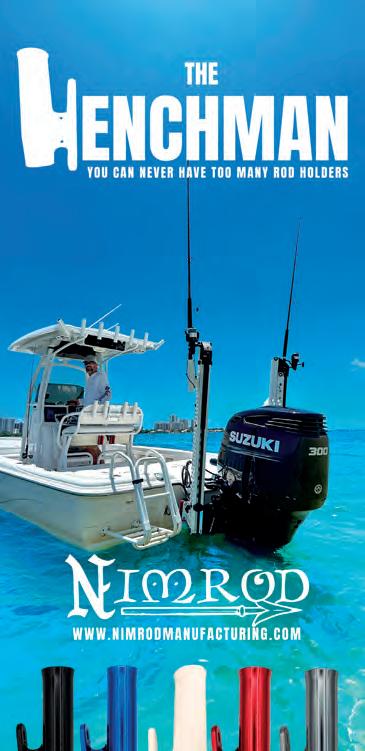

January targets should be pompano, Spanish mackerel, sheepshead, and bluefish. Fishing the beach and the Intracoastal near inlets will be your best bet. The colder the fronts we get, the more fish will push into the river and Intracoastal. Try fishing for pompano along channel edges near your favorite inlet. Launching your kayak at Sawfish Park in Jupiter will put you in good vicinity of some good channels. Pompano jigs, D.O.A. lures 2.75” Shrimp, and a good ‘ole bucktail jig are a few of my favorite lures. Spanish mackerel can give you some nonstop action on the beach and on the Intracoastal. Finding the schools and throwing spoons and bucktail jigs will entice a bite.



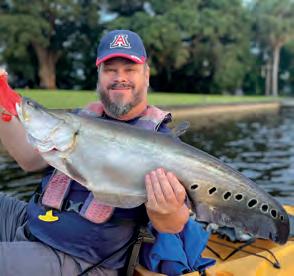
Prepare for being cold and wet when going offshore this time of year. Get a good pair of bibs or light waders from Frogg Toggs to keep you dry while launching and from wave splashes while out there. Sailfish and kingfish will be the most common catches with a random mahi and wahoo in the mix. Slow trolling goggle eyes and blue runners in 90-250 feet of water will be your best bet to get a bite. Don’t forget to grab a few Yo-Zuri Crystal Minnows to troll as well if bait is hard to come by. I like to run a deep diver and shallow runner to cover more of the water column.
Peacock bass and clown knifefish will be chewing this month. Lake Ida, West Park is a good place to launch your kayak. Try 15-to-20-pound YoZuri Topknot Fluorocarbon leader and a 2/0 circle hook casting in and around structure and weed lines to get onto a few clowns with finger mullet and shiners. Look to fish the mid-water column and below by adding a pinch weight to your leader and get that bait in their face. Check out Pushin’ Water Kayak Charters on Facebook, Instagram, and TikTok for all the latest adventures my clients and I get into.











• Great Customer Service

• Unlimited Range Time
• Florida Concealed Weapons Classes
• Firearms Training Courses
Beginner to Advanced & Private Classes
Provided by Florida Firearms Training
• Fully Air Conditioned Range at 72 Degrees

9
4:02 2.6 4:05 2.4 10:09 0.3 10:34 -0.5 7:08 5:47 10 Fri 5:06 2.6 5:09 2.4 11:09 0.2 11:32 -0.5 7:08 5:47
Sat 6:05 2.7 6:08 2.5 12:06 0.1 7:08 5:48






















22
















































FloridaFlatsFishingAdventures.com • (954) 687-5848
FloridaFlatsFishingAdventures@gmail.com





Our South Florida colder months are here, and the weather is outstanding to most anglers. Mornings can be chilly, but the sun seems to be a blessing as it rises and warms us and the water up. We look for shallow flats that warm up quickly or deeper pockets that hopefully still have warm water as snook prefer the water to be over 65 degrees. From our last trip (pictured), a 24-inch bass weighing well over 9 pounds, caught on a small NLBN swim bait with a jig head. Deep in the backcountry, freshwater can be found and because it’s not fished much, we can find large fish. When targeting bass and snook, it’s almost the same tactics. Find branches or current, try to match the bait while throwing artificials, and try a variety of retrieves to get the result you want before moving on to the next spot. You will find more snook
South Florida Fishing Charters • (954) 440-5200 • sflfishingcharters.com
Happy New Year! Here’s to health, happiness, and more fishing in 2025!
January can be a challenging month with the cold fronts that push through but it can also be the best time to catch BIG peacock bass! The Lake Ida chain has been fishing really well. Plenty of good-sized peacocks, snakeheads, and clown knifefish. Lake Ida isn’t known for cichlid fishing but if you put your time in you can catch a bunch of them on live worms and its great action, especially for kids!
Peacock bass will go through some cycles in the next 2 months, it’s always possible to have a spawn happen during winter. This happens when the water temperature gets below 80° for a little while, then goes above 80° for a week or so. It tricks the fish into thinking winter has come and gone and it’s time to spawn! Then, once wintertime comes around, they will already have fry and then will get to
spawn again in the springtime. This happened last year and because of it, the peacock bass numbers seem to be way up this year. One interesting fact about peacocks, they will grow to about a pound in their first year or about 12-14”. They rapidly put on weight after that first year and we have seen plenty of pounders from last year’s double spawn. The best way to find peacocks this time of year is to find moving water, such as spillways, culvert pipes, or dams. Peacocks will sit in this moving water foraging on small minnows and anything that passes through.
The Everglades water is still high but there are plenty of fish to be caught with live bait, fly, and artificial. Look for more reports closer to spring with the anticipation of low water and a dry Everglades season. It’s been two years since the last big die-off of fish so there should be plenty of fish to catch out there.
now in the shallows near mud flats as during low tide. The sun can warm the mud and as the water flows over the mud it also warms. Some snook can be found in colder months in areas where the water just sits still and hopefully stays as warm as possible giving snook a chance to survive cold temperatures. Don’t forget big fish will be hitting smaller baits and sometimes prefer smaller baits that they can digest because the larger baits will sit too long in their stomach. Redfish seem to be in abundance as cooler temperatures aren’t affecting them as much. These fish can be found all throughout Flamingo and so can the pictured goliath grouper. With that said, come out and book a trip with Florida Flats Fishing Adventures. Don’t forget to mention Coastal Angler Magazine when booking with Captain Steve Purser.








Facebook.com/FishingHQ • 754-214-7863 •
January is one of the best months to be on the water, especially for those who enjoy drift fishing and big game sportfishing. With the water temperature hovering in the mid-70s to low-80s, conditions are ideal for a variety of species to thrive, making this month a prime time for anglers looking to reel in some impressive catches.
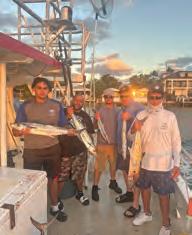
Drift fishing in January is nothing short of exciting. The cooler waters bring in a range of species that anglers can target. Kingfish are a popular catch this time of year, providing thrilling action with their fast runs and strong fight. Along with kingfish, several snapper species are in abundance, including yellowtail, mutton snapper, and mangrove snapper. These colorful fish are not only fun to catch but also great for the dinner table.


Red grouper is another prized catch during January. Their hefty size and firm, white meat make them a favorite among anglers. Additionally, porgies and grunts can be found in the same areas, adding to the variety of species you can expect to catch. The combination of these fish makes for a diverse and enjoyable drift fishing experience, as you never know what will bite next.
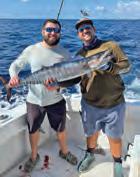
For those who prefer the thrill of sportfishing, January offers ample opportunities to chase big game fish. Mahi mahi, also known as dolphin fish, are often caught in these cooler months. Known for their vibrant colors and acrobatic leaps, mahi provide a rewarding challenge for all anglers.
Kingfish will continue to be abundant, along with blackfin tuna showing up in nice numbers. Perhaps the most coveted catches of the month are the elusive sailfish and wahoo. Both species offer incredible sport for anglers looking for an exhilarating fight. Wahoo, with their razor-sharp teeth and speed, can be a particularly challenging catch, while the sailfish is known for its spectacular jumps and unpredictable runs.

As the water is cool and starts to warm up, big game sharks begin to make their appearance, adding an extra layer of excitement to the fishing scene. Hammerheads, bull sharks, and nurse sharks start showing up in greater numbers, offering an adrenaline-pumping experience for those daring enough to target them.
January offers an ideal environment for both drift fishing and big game sportfishing. Whether you’re targeting a variety of snapper species and grouper on a drift trip or chasing mahi mahi, tuna, sailfish, and sharks on a sportfishing adventure, this is a great time of year to be out on the water. So, gear up, get ready, and enjoy the fantastic fishing that January has to offer. Tight lines everyone and we hope to fish with you soon!





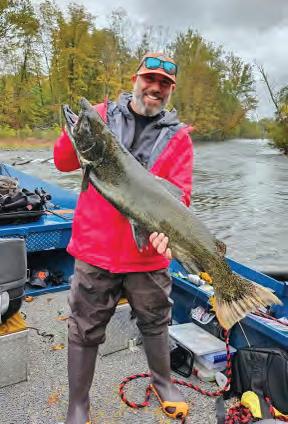
Matt from


making the
run happen on fly on an Upstate NY trip.




















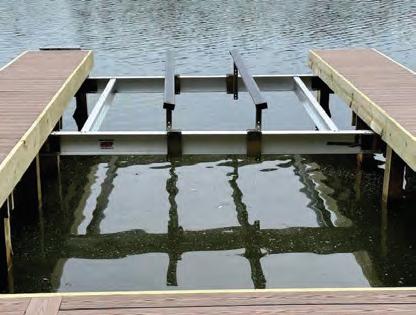




ShoreStation hydraulic boat lifts are a reliable choice for coastal residents and boating enthusiasts alike. Their strong construction, made with corrosion-resistant materials, allows them to withstand harsh environmental conditions, including sun, storms, and saltwater damage. ShoreStation provides a steadfast solution for protecting waterfront investments, o ering peace of mind to owners in the Sunshine State.


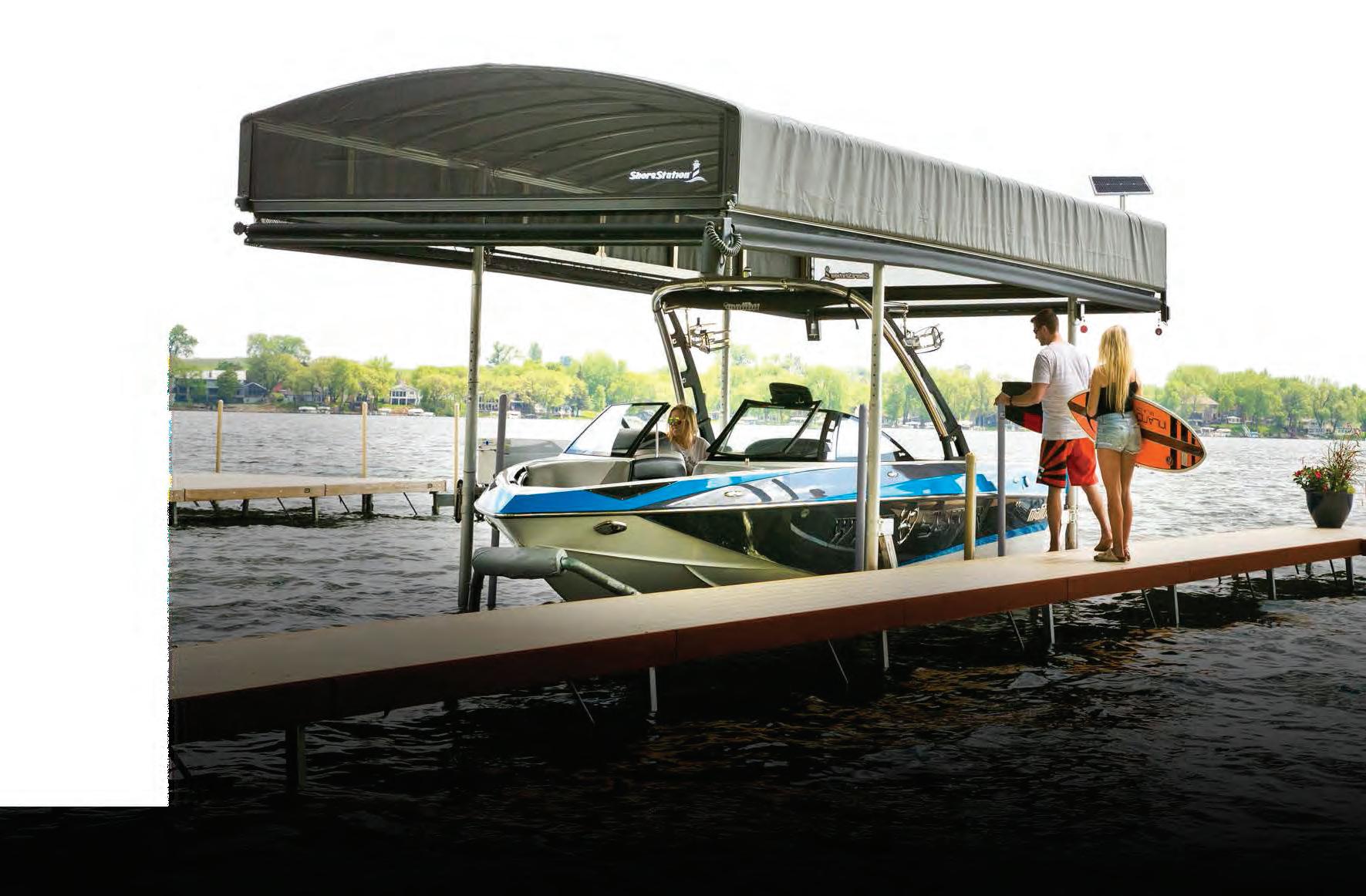





Equipped with exceptional weather resistant fabric and breathable SunTex 80 woven mesh ends for maximum protection and durability, the REVOLUTION™ Series Canopy is the most innovative canopy

Made from the highest quality materials, our innovative hydraulic boat lift is one of the fastest and safest lifts on the market today. When you have a hydraulic lift, there’s no need to worry about wind and waves getting in your way. This lift will give you con dence to safely land and secure your boat in less-than-ideal conditions.
Never miss another moment on the water. Power your lift with clean, free solar power. Our speedy 20 watt charger features solar regulator drainage protection, saving your battery from permanent damage caused by overcharging.



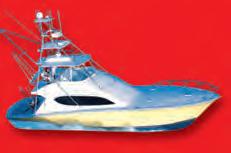




Compare before you sign with any other school www.adamsmarine.com
“NO HIDDEN CHARGES”
Springs - Feb 17
Steinhatchee - Feb 24
- Mar 10 Gainesville - Mar 31
Smyrna Bch - Apr 21
To Reserve a Spot Call: 352-447-1950 Email: info@adamsmarine.com

By A. deGruchy



If you’re looking for an unforgettable start to a 2025 adventure, Islamorada is the place to be. Known as the “Sport!shing Capital of the World,” this gem in the Florida Keys o ers easy access to the Gulf of Mexico, where the waters are packed with some of the most exciting !sh around: cobia and permit.
Cobia are a favorite for good reason. ese !sh are curious, strong, and put up one heck of a !ght. You’ll o en !nd them hanging out near wrecks, buoys, or even %oating debris, and when they bite, you’ll know it. ey can grow up to 60 pounds, so get ready for a battle when one hits your line. ey also make excellent table fare! We are coming up to the best months to target cobia, so de!nitely keep this species in mind when booking a charter.
Permit !shing is next-level stu . ese sleek, silver beauties are as smart as they are strong, making them a bucket-list catch for many anglers. ey love to hang around wrecks and %ats, and they’re picky eaters. ey love crustaceans, but o en get spooked so your casts must be close to perfect. e real thrill of !shing for permit is in the chase. Spotting a permit tailing in the gulf waters, casting just right, and then feeling that line go tight is pure adrenaline. ey’ll test your patience and your skill, but the payo is worth it.
For the ultimate Gulf !shing experience in Islamorada, check out Bean Sport!shing. Capt. Bean specializes in targeting cobia and permit, ensuring a day on the water you’ll never forget. Whether you’re a seasoned pro or a !rst-time angler, his expertise and passion for !shing will make your trip both exciting and successful.
To book a charter, visit www.beansport shing.com. You can also nd Capt. Bean on Instagram @bean_sport shing.

























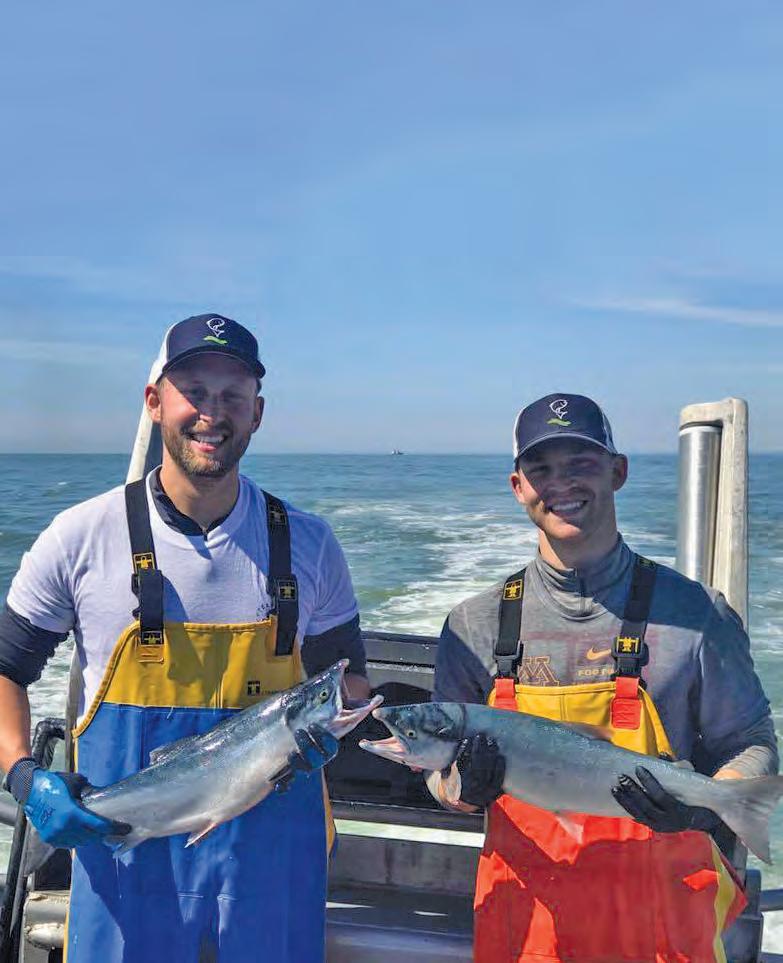




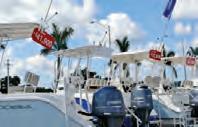


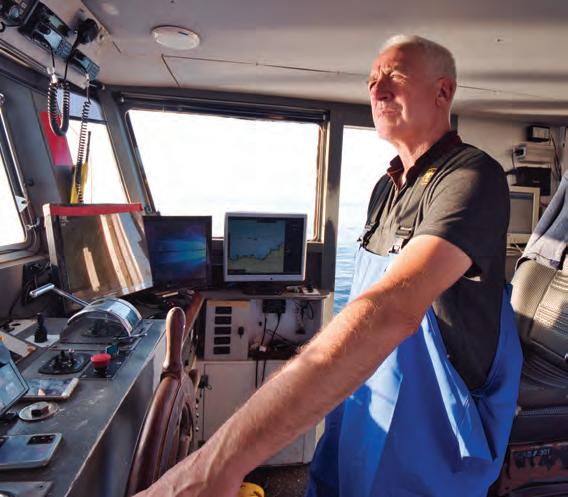





Tim Barefoot
As winter deepens, cooler waters push more !sh o the beaches and toward the warmer edges of the Gulf Stream. With grouper and snapper now o -limits due to regulations, it’s time to shi our focus to productive species still on the table—trigger!sh, vermilion snapper (beeliners), and seabass. For those looking to venture even deeper, deepdropping remains an exciting option.
e December full moon o en marks a turning point in !shing. Grouper and speckled trout seasons wind down, leaving anglers to adapt to what the regulatory environment allows. Fortunately, the stacks of triggers, beeliners, and pelagics in deeper waters o er excellent opportunities. Start your search around the 150-foot mark and use your !sh!nder to locate promising spots.
For precision !shing, modern tools like spot-lock trolling motors—such as the Rhodan or Minn Kota—are game changers. ese motors allow you to hover directly over schools of !sh with ease. However, they can be limited when deploying a kite, as the wind necessary for kite !shing can drain trolling motor batteries quickly. at’s

where anchoring, a classic yet e ective technique, comes into play.
Yes, anchoring may feel like a step back for those spoiled by spot-lock motors, but it’s a reliable method for staying on productive marks without straining batteries. Once anchored, consider adding a kite to your !shing arsenal. Kites are particularly e ective for enticing leader-shy species like yellow!n tuna and wahoo. When properly deployed, they minimize visible leader material in the water, o en resulting in immediate strikes.
provide hardy, versatile bait. Supplement your live bait with cast-netted !sh to use as live chum or cut into chunks.
A sabiki rig is another indispensable tool. Jigging up live bait at your !shing spot o en produces exactly what predatory species are feeding on. Don’t hesitate to use small snapper, grunts, or other bait!sh you catch with a sabiki as o erings on your light line or kite. Wahoo, for example, have been known to eat everything from full-sized grunts to snapper. Frozen or fresh Spanish mackerel also make excellent bait for wahoo and tuna.

Successful kite !shing requires teamwork. Assign one crew member to manage the kite and bait while others focus on !lling the cooler with trigger!sh and snapper. Proper setup is essential. Bring live bait from inshore or nearshore waters; cigar minnows, sardines, pin!sh, and menhaden are excellent choices. A pin!sh trap can also
Experience Fishing during this time of year is about more than just !lling your cooler; it’s about enjoying the process and making memories. Whether you’re targeting bottom-dwellers like trigger!sh or keeping a light line out for the chance at a wahoo or tuna, the key is to stay adaptable and prepared. As always, take the kids along and capture plenty of videos of your adventures. Fishing is more than just a hobby— it’s a way of life.
For more from Tim Barefoot, visit barefootcatsandtackle.com and check out his YouTube channel.








At just six years old, Nathan “Bibil” Barreto is already making waves in the angling world! On July 8, 2024, while !shing Brazil’s iconic Juruena River, Nathan landed an incredible 11.79-kg (26-lb) payara. is catch shattered the IGFA Men’s Smallfry World Record for the species.
Nathan hooked the record-setting payara using cut bait, showcasing his growing skills as an angler. A er verifying the weight on a certi!ed scale, he ensured the safe release of this magni!cent !sh. Nathan’s actions not only highlighted his talent but also demonstrated that conservation is a value no angler is too young to embrace.
e International Game Fish Association (IGFA) has established guidelines for Smallfry World Records to encourage young anglers. Here’s what you need to know:
• Species: Records are maintained for the heaviest !sh of any eligible species.
• Age: Categories exist for male and female anglers aged 10 years and under.
• Weight: Fish do not need to be weighed on land, as long as the weight is veri!ed appropriately.
• L ine Class: Records are recognized for all line and tippet classes covered under IGFA rules.
• Other Rules: All IGFA International Angling Rules apply, except for the standard weighing requirement.
Encouraging young anglers to aim for world record catches—or simply to submit outstanding catches for consideration—o ers a fantastic opportunity to foster a love of !shing. e IGFA’s Smallfry division plays a vital role in promoting the sport among young enthusiasts.
Taking a kid !shing doesn’t just teach them valuable skills—it can improve their lives and create unforgettable memories. Who knows? You might even help them reel in a world record!
For more information on the IGFA Smallfry records division, visit www.IGFA.com.

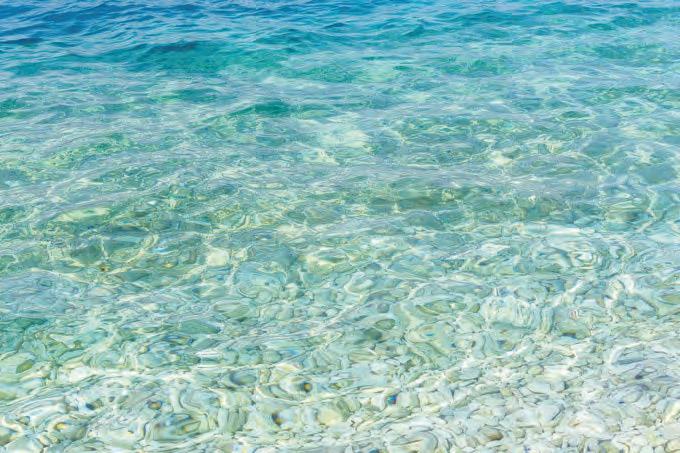




























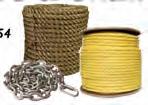





Choosing the right !shing line is crucial for success on the water. Two popular options— braided and mono!lament lines—o er distinct advantages, and your choice o en depends on your !shing style, target species, and conditions. Let’s compare their strengths and weaknesses to help you decide.
Braided line stands out for its high strength-todiameter ratio. Its thin pro!le allows for less drag and greater line capacity on reels, making it ideal for deep-water !shing. For instance, a 30-pound braid can match the diameter of an 8-pound mono!lament. Mono!lament, while thicker, provides added durability and is o en preferred in situations requiring extra shock absorption, such as battling !sh with sudden, strong runs.
Braid has minimal stretch, giving it superior sensitivity. is makes it perfect for techniques like jigging or bottom !shing, where detecting subtle bites is crucial. It also enhances hook-setting power. On the other hand, mono!lament’s stretch acts as a cushion during hard strikes, reducing the risk of breakage.
Mono!lament generally o ers better abrasion resistance, making it a top choice in areas with rocks or heavy cover. However, it is prone to UV damage over time, which can weaken the line.

Braid is more resistant to UV exposure but can fray easily when rubbed against rough surfaces.
Braided line’s thin diameter and lack of stretch give it an edge for long-distance casting, especially in open water. However, mono!lament’s low visibility underwater makes it advantageous for targeting skittish !sh in clear water. To counter braid’s visibility, many anglers use a uorocarbon leader.
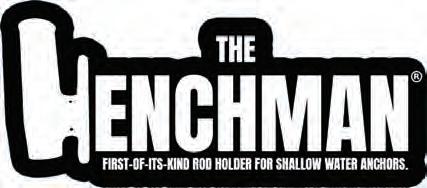
e choice between braid and mono depends on your needs. Braid excels in strength, sensitivity, and casting, while mono shines in shock absorption, abrasion resistance, and stealth. Many anglers carry both to adapt to various scenarios or use a braid mainline with a mono or uorocarbon leader for versatility.
Ultimately, knowing when to use each type can make all the di erence in your !shing success.










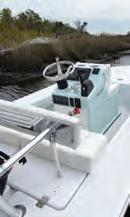









Praise for DiamondAura®
“So much sparkle and the play of light on DiamondAura® beats any diamond!” — D.D. from Columbus, OH
It was the jewelry piece that made the world stop and take notice. In the middle of a long volley during the big American tennis tournament, the chic blonde athlete had to stop play because her delicate diamond bracelet had broken and she had to fnd it. Te tennis star recovered her beloved bracelet, but the world would never be the same.
From that moment on, the tennis bracelet has been on the lips and on the wrists of women in the know. Once called eternity bracelets, these bands of diamonds were known from then on as tennis bracelets, and remain the hot ticket item with jewelers.



A classic tennis bracelet serves up over 10 carats of sparkle for a guaranteed win
with D Flawless diamonds from another company that costs $57,000!
Want to look like a million bucks without stressing over losing or damaging something that cost you a fortune? Te Love Wins Tennis Bracelet is a simple strand of glittering gems in precious sterling that epitomizes elegance.

FREE earrings with your purchase of the Love Wins Bracelet.

Te frst time we ofered this bracelet, we sold out literally in minutes. It was our fastest selling product of 2021. It took six months to get it back in stock — Get yours before we run out!
And there’s more... we will also include our Ultimate Diamond Alternative™ DiamondAura® stud earrings for FREE!
Jewelry Specifcations:

• 10 ¾ ctw of the Ultimate Diamond Alternative®, DiamondAura®
• Rhodium-fnished .925 sterling silver settings
• Bracelet: Fits wrists to 7 ½". Earrings: 1 ctw with post backs


We’ve captured this timeless classic with over 10 total carats of DiamondAura®, our signature diamond alternative stone. Tis sparkling marvel rivals even the fnest diamonds (D Flawless) with its transparent color and clarity, and both are so hard they can cut glass. Don’t believe me? Te book “Jewelry and Gems – Te Buying Guide,” praised the technique used in our diamond alternative DiamondAura®: “Te best diamond simulation to date, and even some jewelers have mistaken these stones for mined diamonds,” it raved. For comparison, we found a similarly designed 10 carat tennis bracelet
Love Wins Tennis Bracelet (10 ¾ ctw) $399 $39* + S&P
FREE stud earrings (1 ctw) with your purchase of the Love Wins Bracelet — a $99 value!
*Special price only for customers using the offer code.

Your Offer Code: LWB324-02



